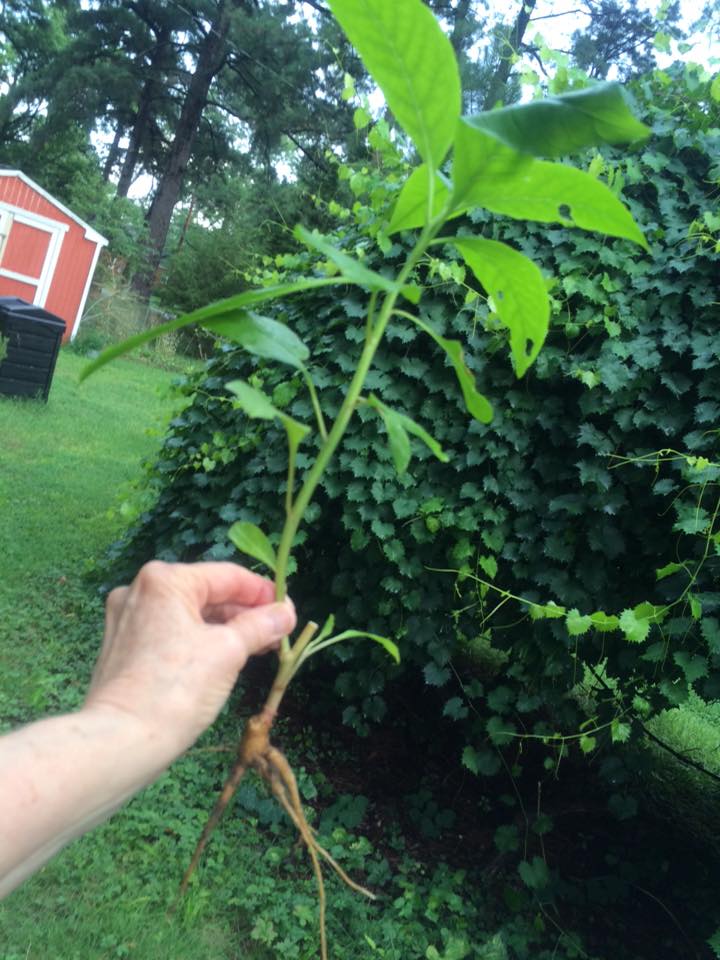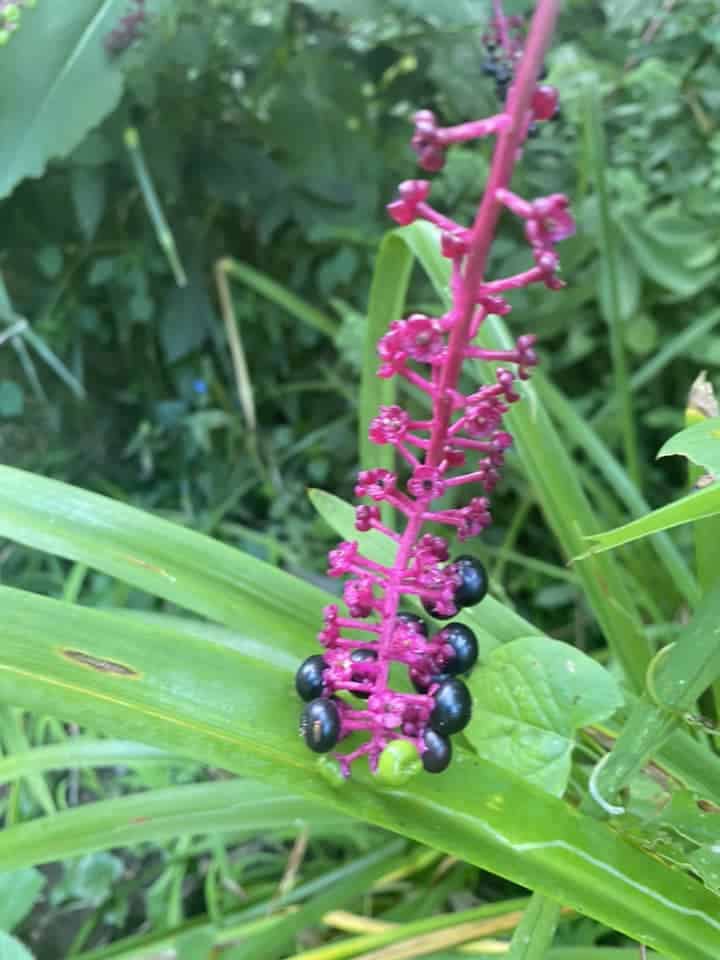Pokeweed produces purple-black berries giving an attractive look to your garden, but this landscape weed has poisonous effects even to the touch.
So stay with the article till the end to know the precautionary steps to avoid possible Pokeweed symptoms and re-growing them.
Table of Contents Show
Is Pokeweed Poisonous to Touch?
Once recognized as traditional medicine, Pokeweed has become a poison for humans, pets, and livestock.
Every part of Pokeweed, from the rootstock to the stem and leaves, is poisonous even without getting into your stomach.

These poisonous substances are present in the roots, berries, and seeds, entering the bloodstream of humans even when touched.
The toxins can form a chain reaction inside the body and hamper the digestive and respiratory systems.
Comparatively, mature plants have higher toxins levels than young ones.
According to research from NC State Extension, Phytolacca Americana var. rigida has high poison severity, possessing toxicity classes 1 and 2, while Phytolacca Americana has medium poison severity in humans.
And if you are a pet lover, you need to remove the Pokeweed as soon as you notice them since they are poisonous to touch.
Consult the video for further details!
What are the Symptoms of Touching Pokeweed?
Also known as American nightshade, Pokeweed is omnipresent in the United States, and any of us can encounter them unknowingly.

The common symptoms of touching Pokeweed include skin irritation and respiratory and digestive issues.
However, look at the symptoms below to be sure if the discomfort is really from Pokeweed.
| Symptoms | Ways of Checking |
|---|---|
| Convulsions (Seizures) | Sudden difficulty in breathing due to drop in blood pressure and lack of oxygen in brain. |
| Skin Irritation | The exposed part to the toxin feel itchy and turn to red rashes. In mild cases, skin become blotchy and prickling discoloration occurs. In severe cases break out of spreading blisters take place. |
| Muscle Spasms | Cramps in different body parts like hand and feet due to lack of blood circulation to the muscles. |
| Inconsistent Heartbeat | The blood pressure and heartbeat decreases at first. After some movement, heartbeat increases due to adequate blood flow. |
| Headache | Gradual pain on the both side of the head. The pain increases with time and might hamper vision. |
| Nausea and Vomiting | Discomfort in stomach and feel like throwing up. Lack of appetite may be triggered and salvation increases. |
| Diarrhea | Liquid stool In severe condition, blood is seen along the stool. |
The roots, stems, leaves, and berries of Pokeweed cause an allergic reaction similar to the toxic behavior of oak or ivy.
What to do if You Touch Pokeweed?
The poisonous symptoms may take at least 2-6 hours to appear, so you can have plenty of time to prevent them and save pets and humans from undergoing severe conditions.
Here are some treatments that can help to lessen the impact to a certain extent.
First Aid Treatment
First, be calm! The initial stage of poisoning may not be deadly if noticed earlier and can be cured with first aid knowledge.
- Immediately contact the local Poison Control Center on their Poison Helpline number (1-800-222-1222) from any location in the United States.
- Do not make the person vomit until recommended by the control department.
- Avoid scratching the skin area even if you feel itchy, as that can spread the poison over the skin.
- If the rash is mediocre, wash off the affected area with soapy water, and better to use lukewarm water.

- Immediately apply a topical cream rich in corticosteroids like hydrocortisone and avoid using antihistamines or benzocaine as they may worsen the situation.
- Try using an ice pack over the rashes for about twenty minutes until you see the rashes dissipate.
However, if the situation has worsened than your expectation, seek medical treatment as soon as possible.
In most cases, recovery takes about 24-48 hours for mild toxicity discovered in the early stage.
How to Grow Pokeweed with Safety Measures?
Although each part of Pokeweed has toxicity, Europeans and Americans love growing it for its shiny berries and reddish stems.
If you also like to grow Pokeweed, consider the points below for tips with the utmost safety.
- Firstly, wear gardening gloves to prevent direct contact with the plant berries and to collect seeds from the berries, or you can buy Pokeweed seeds.
- Do a water test on the seeds and throw away the seeds that float as they are non-viable and soak for two days.
- Drain out the water and let the seeds dry on a paper towel.
- Place the Pokeweed seeds in a plastic zip bag and put it inside the refrigerator for cold stratification at a temperature of 40ºF for at least three months.
- After the seeds have germinated, choose a location that receives both direct sun and partial shade, preferably in the backyard.
- Soil can be of any type since Pokeweeds can thrive on any land but try to keep the pH within the range of 4.7-8.0 and should be compost-rich.
- Now, plant the germinated seedlings in early spring.

- Keep the row distance about four feet apart and plant to three feet. However, plant the seedlings closer if you only use young leaves.
- Cover the seed lightly with the soil to enhance germination.
You can multiply the Pokeweed even from the roots, but better to avoid it, as the roots have the highest level of toxicity.
How to Get Rid of Pokeweed?
Pokeweeds can be your ally if the growth is limited and foe at the same moment if it goes as an invasive weed.
And at the time of invasiveness, it is better to remove the Pokeweed entirely. For that, follow the steps given below.
- Mature Pokeweeds tend to have a deep-rooted system, so it would be a bad option to pull it out.
- However, you can pull out young seedlings of Pokeweed, but before pulling, wear gloves and full-sleeve clothes, as Pokeweed is poisonous even to the touch.
- Dig out the roots using a spade and pull out the tap root completely.
- Also, check out any ripe berries in the cultivation areas to prevent re-infestation of Pokeweed.
- Check under the tree canopies, rows of fences, and the areas below perches for early detection.
- Do foliar spray using weed killer containing at least 61% active ingredient of Triclopyr like Brushtox Brush Killer, mixing 1-1.25 ounces of total product in a gallon of water.
- Alternatively, you can mix 6.5 ounces of Triclopyr of 61% active ingredients with 13 ounces of seed oil per gallon of water.

- Spraying 2.5-4 ounces of 41% of Glyphosate as the active ingredient per gallon of water can control the Pokeweed to the most extent.
- But be cautious not to spray the glyphosate solution on nearby plants and grasses as it can kill them too, and choose a sunny day.
FAQs on the Toxicity of Pokeweed
Is Pokeweed a skin irritant?
The Pokeweed is not as allergic causing as poison ivy, but some might be intolerant to the sap of the berries, leading to itchiness and rashes on the skin.
So better to avoid the touch with the sap of any part of Pokeweed.
Does anything eat Pokeweed?
Birds like Cardinals, Catbirds, Hummingbirds, and Pigeons feed on berries, the major medium for seed dispersal.
The toxic effect is not observed in smaller mammals like mice, raccoons, and opossums.
However, mammals like horses, cattle, and dogs suffer severely from Pokeweed toxicity.
Final Thought
Pokeweeds seem attractive for their grape-like and beautiful purplish berries and have therapeutic effects in treating rheumatism, tonsilitis, and anxiety.
However, Pokeweed is poisonous if you are not handling them carefully and can severely affect you from the touch.
So do not hurry to touch the Pokeweed, and adhere to the required precautions.


